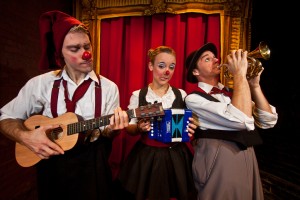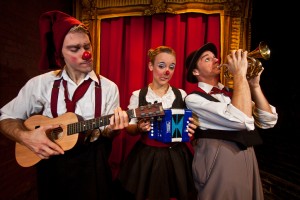EXCLUSIVE: Clowning around with the Piccolini Trio (Part I)

The Piccolini Trio, consisting of Joy Powers, Joshua Shack and John Stork, are ready to set up camp at the Canal Park Playhouse in downtown Manhattan, Jan. 7-29. Their clown act, cleverly titled Circus in a Trunk, spawns from the simple question: What should a group of performers do if the circus never arrives?
For more information on the show, click here. Tickets are priced at $20; performances run on Saturdays and Sundays at 2 p.m. and 4 p.m.
Recently, Hollywood Soapbox exchanged e-mails with the triumvirate of talent behind the Piccolini Trio. Here, we present the first in a three-part series about the upcoming engagement of Circus in a Trunk.
The first installment focuses on Joy Powers, an alumna of Circus Smirkus and Ringling Bros. and Barnum & Bailey. She also narrated the documentary Circus Dreams for director Signe Taylor.
You all have varied circus careers. How did you come together and develop Circus in a Trunk?
We all got our start in Circus Smirkus. Josh and John toured together there and I did a few years later, and that’s how we met. Josh was actually my counselor!
Josh and I worked together a few times, and our characters and clowning style just clicked. After I finished my first year with Ringling Brothers, Josh and I officially formed the Piccolini Trio with another Smirkus clown, Shea Vaccaro. When he was no longer able to work with us, we were looking for another person, and realized John would be great.
He was!
John has been a great addition to the Trio, and has helped develop a lot of the material we were working on before, as well as added some of his own.
Circus in a Trunk is a collection of our best acts and clown pieces, and creative little bits we’ve made. We worked on some of the material together, some separately, and Josh put it all into the order it is in now.
The show is a combination of contemporary and classical European clowning … I was wondering if you could elaborate a bit on how you chose the acts for the show and who were your influences.
Our influences and inspirations are probably too many to count! There’s a whole cache of clowns who we’ve watched and learned from over the years, whether it was by seeing them perform in person (the best!), looking at old videos, or simply through personal relationships.
Some of our acts (such as “Little Bee”) are classic European gags that several different clowns have performed for generations and generations. We perform those classics in our own unique way, with our personal touches that make it funnier and more fitting for us.
We’ve also created original material, which we continue to work on. Many of these pieces were carefully written, rehearsed and re-worked, and many just came from jokes we had among ourselves that evolved into something for the show! Those are definitely some of my favorites.
What’s the biggest challenge of being a working clown?
There are a lot of challenges, and that’s why you may find that a lot of performers like us really love what they do. You have to! We travel a lot, which is really fun, but we miss home and family. We have to be “on” a lot of the time, which means leaving any personal problems at the door.
We must be good with children, while providing something for the parents as well. And to be honest, we certainly aren’t getting rich doing it. Our jobs can be strenuous, embarrassing, stressful and exhausting, but it’s what we do.
One of the biggest challenges is that, here in America at least, there is a pretty common set of misconceptions about clowns. Some people think clowns are only for children, or that all we do is make balloon animals and honk horns, and many people think clowns are scary.
All not true!
People often leave our show with a very different definition of the word “clown” than when they came in.
Being a clown is a constant effort. But, like I said, we really do love what we are doing, and we are having a lot of fun together. We get so much back from the audience, and that makes everything worth it.
Could you describe some of the audience reactions over the years, and namely what you expect for Circus in a Trunk? I imagine the kids in the audience enjoy the clowning at one level, while the adults enjoy it perhaps for different reasons. How do you cater to both age groups?
We’ve had a lot of really positive reaction to our show, from children and adults alike, which is so wonderful! People always come out with a smile on their face, and when we greet them after the show they say, “I really liked the part when…”
I just love to hear that stuff.
We always take what we hear from the audience into consideration when we are reworking something. We want them to feel delighted, and that is what we’ve heard back many times.
Kids tend to like more physical humor, silly things, visual things and mischievousness. Adults appreciate the wittiness, audience participation and running jokes throughout the show along with some of the more subtle humor going on.
We really think of our show as being geared toward children and adults equally. It’s pretty cool because clowning is one of the places where that can really happen, and we’re so happy when everyone is enjoying themselves.
What’s the rehearsal schedule/commitment like for a clowning show like Circus in a Trunk? Sometimes there might be a stigma that clowning is all improvisational, but I imagine there’s hours of fine tuning and crafting of the performance. Could you explain?
We have been working on this show for about two years, so it is pretty familiar to us at this point, but there is a lot of rehearsal still to be done before it will be ready for this run. We have a list of things to work on and fine tune, and these things take lots of time together.
There are hours of creation and discussion (as well as assemblage of props, costume and set), behind most of what you see, so no, it really is not improvisational for us. Not to say that improvisation is a negative thing at all, there are a few points in our show when we use it, and I personally find it very difficult! We put a lot of consideration and effort into our show, and we hope that comes across!
By John Soltes / Publisher / John@HollywoodSoapbox.com
-
In the coming weeks, we’ll have interviews from the other two vital parts of the Piccolini Trio.

